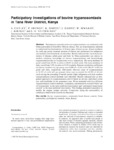| dc.description.abstract | Participatory research on bovine trypanosomiasis was conducted with Orma pastoralists in Tana River District, Kenya. The use of participatory methods to understand local perceptions of disease signs, disease causes, disease incidence by cattle age group, seasonal patterns of disease and preferences for indigenous and modern control methods are described. Results indicated that local characterization of diseases called gandi and buku by Orma pastoralists was similar to modern veterinary knowledge on chronic trypanosomiasis and haemorrhagic trypanosomiasis (due to Trypanosoma vivax), respectively. The mean incidence of gandi varied from 10.2% in calves to 28.6% in adult cattle. The mean incidence of buku varied from 3.1% in calves to 9.6% in adults. Pearson correlation coefficients for disease incidence by age group were 0.498 (P < 0.01) and 0.396 (P < 0.05) for gandi and buku, respectively. Informants observed cases of trypanosomiasis in 24.1% of cattle (all age groups); these cases accounted for 41.8% of all sick cattle during the preceding 12‐month period. Eight indigenous and three modern trypanosomiasis control methods were identified. Results indicated that an integrated approach to trypanosomiasis control based on private, individual action was well established in the assessment area. When presented with four different trypanosomiasis control methods, community representatives selected ‘better use of trypanocides’ as the most preferred intervention and ‘community‐based tsetse control’ as the least preferred intervention. This finding prompted researchers to modify the original project activities. Constraints facing the sustainability of community‐based tsetse control are discussed. | en_US |

